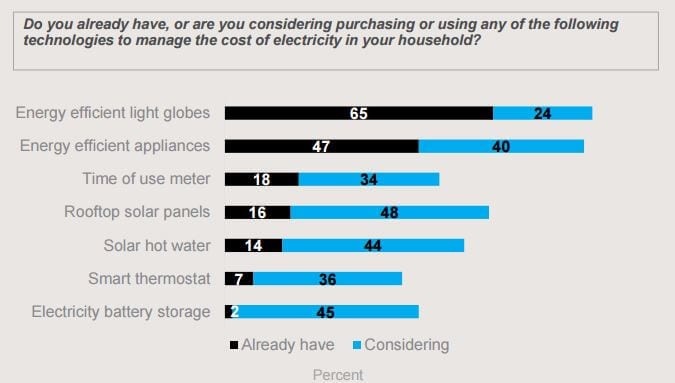Newly released survey data suggests that, with a few exceptions, we may have dramatically underestimated the take up of battery storage in Australia.

Recently, I had the privilege of speaking the CEC Australian Clean Energy Summit 2016. I was part panel of solar energy experts focused on the topic of “Putting Consumers First” looking at the impact of regulations, policy and technology on energy and solar consumers past and present.
We had a good session including some great data and vigorous debate about retailers and networks in particular inciting courteous but hearty defense from several retailers in the audience.
One of my co-panellists was David Havyatt from Energy Consumers Australia (ECA) who presented some fascinating new data.
Who is the ECA, you ask? The ECA was established on in January 2015 as an initiative of the Council of Australian Governments (COAG) Energy Council, in order to advocate on national energy market matters of strategic importance and material consequence for energy consumers, in particular household and small business consumers.
ECA assumed the granting functions previously undertaken by the Consumer Advocacy Panel (CAP).ECA is funded through energy market participant fees collected by the Australian Energy Market Operator (AEMO), and ECA’s budget is approved by the COAG Energy Council.
Who knew!?
Anyway, the fascinating bit out of this is that the ECA has been conducting a fair bit of research including some surveys that include solar and storage. Following David’s presentation, I jumped into the report and was blown away by some of the findings.
The survey asked around 2200 consumers and 500 small businesses one question that was of particular interest to me which was this: “Do you already have, or are you considering purchasing or using “ELECTRICITY BATTERY STORAGE” to manage the cost of electricity in your household?”
The result was that according to their respondents, a staggering 2% of homes ALREADY HAVE STORAGE.
If this is extrapolated out to all 1.5M solar homes it implies 31,000 battery storage systems are already in the market, compared to common estimates of around 2,000 systems from other organisations like Morgan Stanley.
I called the ECA and confirmed that whilst their sample size is small, it is reasonably statistically representative of the broader population but of course there is a margin for error. Respondents can get confused, make mistakes and so on.
I also called Morgan Stanley and spoke to them about their recent report on the market, seeking their opinion on the validity of their numbers – and those from the ECA. Whilst they were highly skeptical of the “thirty thousand storage systems” implied, they did acknowledge that empirical data on storage is extremely hard to come by (almost non existent) and most of their numbers are based on reasonable anecdotal discussions and data points.
I also looked back at some battery forecasts that I produced in 2015 when I was still consulting to industry (and verified with a number of key manufacturers and suppliers) and presented publicly. In that case, I had forecast total energy storage products of 15,000 systems in 2016 or about 1% of the total PV installed.
This was based predominantly on the assumption that around 5% of NSW solar owners (exiting the GFIT) would adopt storage and the market would progress through an orderly but rapid growth phase. Frankly, I don’t see this happening at the rate we hoped for and it’s been chaotic rather than orderly. The economic proposition is still challenging, products and constantly changing and the skill set to sell and install is complex.
However, for the sake of the argument, let’s say the data the ECA collected was incorrect for some reason and that the responses overestimated the percentage WITH storage by a factor of 4 times; this still implies 7,700 battery systems and is still a long way above 2000. Notably, the survey didn’t ask how much storage was installed or what type.
In rough terms, to get to 31,000 systems installed( predominantly over the last twelve months) it would imply that more than 20% of all PV sales have included storage and that industry could sell and install around 650 systems per week across the nation – it’s conceivable but would undoubtedly blow most people’s minds the full length of the Tesla Gigafactory.
So maybe, just maybe, there is a chance that we have grossly underestimated the number of storage systems that have actually been installed!?
I recently learned that Roy Morgan research have been conducting surveys on Pizza Sales for more than 5 years and there is excellent granular data on that market (did you know “the size of the overall pizza-eating population didn’t change dramatically last year, but where they got their pizza from did?”, and that incredulously “745,000 people per month visit or buy from Pizza Hut?” (WHO ARE YOU PEOPLE????)
My point here is that the Pizza market is worth around $650M p/a compared to solar around $2.5B and storage at perhaps $200M, but we know more about Pizza sales than storage sales.
Personally, I think this data is not representative of the broader market but is a fascinating data point worth drilling into by the ECA and I commend their efforts to collect it. I suspect the real number is perhaps more like 2000-5000 (1.2% to 3% of new sales) at the upper end so far but either way, it highlights that the market may be bigger than we knew or expected.
(My previous forecast is below)

Nigel Morris is CEO of solar and battery storage company Roof Juice.







